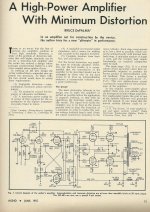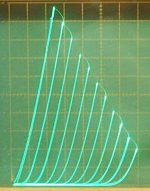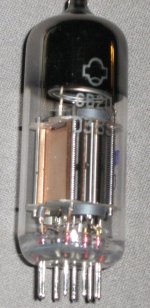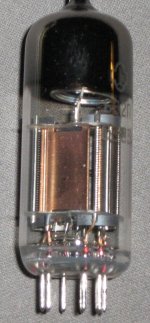ever heard of a "secondary emission tetrode" ?
always thought secondary emission is to be avoided, here it seems to be used to boost gain.
the russian 6V2P 6В2П has gm of 300 (!)
http://frank.pocnet.net/sheets/112/6/6V2P.pdf
dynode electrode usually connects to half the plate voltage carrying the secondary emission current away, which is of course wasted power;
I wonder whether and how high mu can be obtained from a gm of 300 when triode connected ... any usefulness ?
the only other examples I found are EE50 (pre WW-II TV, gm=14) and EFP60 (1948, mu=110)
http://frank.pocnet.net/sheets/153/e/EE50.pdf
http://frank.pocnet.net/sheets/030/e/EFP60.pdf
always thought secondary emission is to be avoided, here it seems to be used to boost gain.
the russian 6V2P 6В2П has gm of 300 (!)
http://frank.pocnet.net/sheets/112/6/6V2P.pdf
dynode electrode usually connects to half the plate voltage carrying the secondary emission current away, which is of course wasted power;
I wonder whether and how high mu can be obtained from a gm of 300 when triode connected ... any usefulness ?
the only other examples I found are EE50 (pre WW-II TV, gm=14) and EFP60 (1948, mu=110)
http://frank.pocnet.net/sheets/153/e/EE50.pdf
http://frank.pocnet.net/sheets/030/e/EFP60.pdf
Last edited:
6V2P doesn't look very well specified... also pulse rated. Who knows.
I have, in fact, heard of them; the article basically said they were not really worth the added hassle. Although secondary electrons moving backwards introduces additional path length, worsening high frequency performance (transit time), the increased gain about balances that out, so that performance is at least similar, or a little better, but not a lot. I suppose frame grid triodes, tetrodes and pentodes are easier to build and use, so they largely went with those instead.
Why you'd be thinking of triode-strapping them, I have utterly no idea.
Tim
I have, in fact, heard of them; the article basically said they were not really worth the added hassle. Although secondary electrons moving backwards introduces additional path length, worsening high frequency performance (transit time), the increased gain about balances that out, so that performance is at least similar, or a little better, but not a lot. I suppose frame grid triodes, tetrodes and pentodes are easier to build and use, so they largely went with those instead.
Why you'd be thinking of triode-strapping them, I have utterly no idea.
Tim
I know, they were a dead end already in the 1950's.
just spotted that 6V2P - 2amp pulse rated as you say, also has 1.6amp heaters - for a mere 3W plate, not very attractive for a small signal application.
why triode ? to make a single stage triode with mu in the hundreds perhaps ... ?
I know, is easy with pentode, but I think ordinary triodes over 100 don't exist.
just spotted that 6V2P - 2amp pulse rated as you say, also has 1.6amp heaters - for a mere 3W plate, not very attractive for a small signal application.
why triode ? to make a single stage triode with mu in the hundreds perhaps ... ?
I know, is easy with pentode, but I think ordinary triodes over 100 don't exist.
Out of curiosity I remembered reading about an amplifier that used the secondary emission EFP60. So I dug around in my old Audio magazines and found it. They're not triode connected though but are none the less odd tubes. I have a bunch of these but no sockets. Maybe someday. 😉 The full article can be found here.
Attachments
but I think ordinary triodes over 100 don't exist.
Any of the pulse regulator triodes (6HV5, 6HS5, 6JD5...) have a Mu of 300 a Gm in the 60,000 range and a plate dissipation rating of 25 to 35 watts. A2 operation is required for use at reasonable plate voltages. These are useful to the direct drive ESL crowd.
The 6BK4 has a Mu of 2000, but it is useless since it needs a plate voltage of about 25 KV.
Secondary emission tetrodes were used in early radar experiments for oscillators due to the negative resistance region. Don't know if they were ever commercialized due to the invention of the magnetron.
Those secondary emission tubes look to be very inefficient. The plate V has to stay above 250 V to get the secondary emission multiplication effects (or k2 eats the current at 150 V). Vg2 needs to be high enough to accelerate the electrons to cause the secondary emission at k2 (which must be some highly emissive surface). So I don't think these will work well as triodes. They would have a sudden expansion in current above Va at 250 V. With very ordinary low gm triode specs below that. Would be interesting to see one in triode mode on a curve tracer though.
Special effects tubes maybe. Too expensive anyway.
Thank goodness for frame grids. 1 $ Frame grid 10 Watt tube in triode mode attached:
(eats 300Bs for breakfast)
Special effects tubes maybe. Too expensive anyway.
Thank goodness for frame grids. 1 $ Frame grid 10 Watt tube in triode mode attached:
(eats 300Bs for breakfast)
Attachments
Last edited:
@HollowState: thanks for the article find, will study ...
The Sovjet 6V2P is described in another source as suitable for "application in nanoseconds pulse circuits of stationary installations" --> that could mean ground based radar ...
and a scientific paper from 1965 mentions it:
A NANOSECOND LIGHT-PULSE GENERATOR WITH EXTERNAL SYNCHRONIZATION
A. P. Onuchin
Institute of Nuclear Physics, Siberian Division, Academy of Sciences, USSR (Novosibirsk)
(Received June 28, 1965)
A generator of light pulses of 1 nsec is described.
"the 6V2P was tested for this purpose. In its usual state the tube is closed. Pulses 100 v in amplitude with a rise time of 5 nsec are delivered to the control grid. Discharge time of capacitance C„ is 2 nsec. This circuit operated for a long time at a frequency of 10 kHz. Synchronization accuracy was better than 0.3 nsec"
today femto sec pulses are common but in 1965 1ns was possibly a great thing ...
even if not suitable for anything here, at least it looks good as a collector's item, it actually does have frame grids (control and screen) and solid gold plates 😉 well, don't know, could be brass, or nickel-copper alloy or whatever produces maximum secondary emissions ... looks goldish though ...
can try to plot some curves ...
The Sovjet 6V2P is described in another source as suitable for "application in nanoseconds pulse circuits of stationary installations" --> that could mean ground based radar ...
and a scientific paper from 1965 mentions it:
A NANOSECOND LIGHT-PULSE GENERATOR WITH EXTERNAL SYNCHRONIZATION
A. P. Onuchin
Institute of Nuclear Physics, Siberian Division, Academy of Sciences, USSR (Novosibirsk)
(Received June 28, 1965)
A generator of light pulses of 1 nsec is described.
"the 6V2P was tested for this purpose. In its usual state the tube is closed. Pulses 100 v in amplitude with a rise time of 5 nsec are delivered to the control grid. Discharge time of capacitance C„ is 2 nsec. This circuit operated for a long time at a frequency of 10 kHz. Synchronization accuracy was better than 0.3 nsec"
today femto sec pulses are common but in 1965 1ns was possibly a great thing ...
even if not suitable for anything here, at least it looks good as a collector's item, it actually does have frame grids (control and screen) and solid gold plates 😉 well, don't know, could be brass, or nickel-copper alloy or whatever produces maximum secondary emissions ... looks goldish though ...
can try to plot some curves ...
Attachments
Last edited:
Here is another one:
http://frank.pocnet.net/sheets/084/1/1630.pdf
lovely ...
"The Orbital-Beam Secondary-Electron Multiplier for Ultra-High-Frequency Amplification"
H. M. Wagner, W. R. Ferris
Journal: Proceedings of The Institute of Radio Engineers , vol. 29, no. 11, pp. 598-602, 1941
A little more thinking about these, and it occurred to me that the electron multiplication will not occur if the dynode and the plate are at the same potential. Normally the dynode is less positive than the plate, so the cloud of secondaries fly off to the plate. In triode, this would not happen if the dynode is connected to the plate. Just a cloud of secondary emission getting re-absorbed by the dynode.
One could prevent the secondaries altogether by grounding the dynode (to cathode), but this may reduce the grid 1 gm some by acting as a shield (from the + plate, but not from + g2, so g2 will soak up the cathode current instead, melting). Maybe set the dynode up at just +50 V as a compromise to minimize the secondaries, but allow the primary cathode stream to pass. The EFP60 datasheet has a secondary generation curve on page C. The dynode starts soaking up the secondaries above +160 V. Becoming a net electron absorber at +230 V.
If the dynode is connected to the plate (along with g2), you will want to measure dissipation in these electrodes. Looks like the dynode may be constructed like a Venetian blind, with near total intercept of the cathode stream. In which case, the dynode will become the plate essentially. Probably melting down. Although some of the secondary emission materials are oxide coatings, so it might self protect in this case. At least for a while. Wikipedia mentions that these secondary emission surfaces tend to have a shorter lifetime. (than tubes in general)
One could prevent the secondaries altogether by grounding the dynode (to cathode), but this may reduce the grid 1 gm some by acting as a shield (from the + plate, but not from + g2, so g2 will soak up the cathode current instead, melting). Maybe set the dynode up at just +50 V as a compromise to minimize the secondaries, but allow the primary cathode stream to pass. The EFP60 datasheet has a secondary generation curve on page C. The dynode starts soaking up the secondaries above +160 V. Becoming a net electron absorber at +230 V.
If the dynode is connected to the plate (along with g2), you will want to measure dissipation in these electrodes. Looks like the dynode may be constructed like a Venetian blind, with near total intercept of the cathode stream. In which case, the dynode will become the plate essentially. Probably melting down. Although some of the secondary emission materials are oxide coatings, so it might self protect in this case. At least for a while. Wikipedia mentions that these secondary emission surfaces tend to have a shorter lifetime. (than tubes in general)
Last edited:
Those secondary emission tubes look to be very inefficient. The plate V has to stay above 250 V to get the secondary emission multiplication effects (or k2 eats the current at 150 V). Vg2 needs to be high enough to accelerate the electrons to cause the secondary emission at k2 (which must be some highly emissive surface). So I don't think these will work well as triodes. They would have a sudden expansion in current above Va at 250 V. With very ordinary low gm triode specs below that. Would be interesting to see one in triode mode on a curve tracer though.
Special effects tubes maybe. Too expensive anyway.
Thank goodness for frame grids. 1 $ Frame grid 10 Watt tube in triode mode attached:
(eats 300Bs for breakfast)
what is it?😀
A little more thinking about these, and it occurred to me that the electron multiplication will not occur if the dynode and the plate are at the same potential.
took some measurements today on 6V2P sovjet impulse SETetrode and I did exactly that:
1) tied the plate, the dynode and the screen together as anode; took (by hand, no curve tracer) some curves, up to 300v they look exactly like an ordinary triode's; gm=10, mu=25.
2) screen at 150v, plate and dynode tied together as anode; curves are those of an ordinary tetrode;
3) screen tied to dynode at 150v; plate at 300v; G1 scan starts with the tube cut off:
-12 v 0 mA
-6V 0.9 mA
-5.5v 2.5 mA within a few mv below -5.5v the current jumped to 150 mA and hit the current limit of my regulator
-5.2v 150 mA + (PS limit)
-12v 7mA
-20v 0 mA
it seems that the SE effect is like massive positive feedback and shows hysteresis, it takes -20v to cut the tube off again; this tube is clearly designed to produce sharp pulses and not for linear amplification; once fired the on-resistance could be very low ...
Last edited:
"What is it?"
Its the Tube From Hell, or TFH.
It all Starts here:
http://www.diyaudio.com/forums/tubes-valves/278043-6ge5-triode-14.html#post4444638
PM me if you can't figure out the puzzle. 6AH9 has the same tube section for its pentode.
They were on sale for a $1 at ESRC on their $1 list recently. Still listed there, but I think these may be only the small RCA made ones left now.
Summer Dollar Days - Vacuum Tube Sale - $1.00 Vacuum Tubes
Basically, they all sold out in a week. You can still get them (the great MADE by Sylvania ones, but not necessarily labeled Sylvania) for $4 off the standard price list, or for $3 at Vacuumtubes.net
The TFH label business started because a previous super tube on the list, the 6HB6, had all 30,000 tubes in the US bought up by some Hong Kong buyer after it got talked up on a few threads.
Its the Tube From Hell, or TFH.
It all Starts here:
http://www.diyaudio.com/forums/tubes-valves/278043-6ge5-triode-14.html#post4444638
PM me if you can't figure out the puzzle. 6AH9 has the same tube section for its pentode.
They were on sale for a $1 at ESRC on their $1 list recently. Still listed there, but I think these may be only the small RCA made ones left now.
Summer Dollar Days - Vacuum Tube Sale - $1.00 Vacuum Tubes
Basically, they all sold out in a week. You can still get them (the great MADE by Sylvania ones, but not necessarily labeled Sylvania) for $4 off the standard price list, or for $3 at Vacuumtubes.net
The TFH label business started because a previous super tube on the list, the 6HB6, had all 30,000 tubes in the US bought up by some Hong Kong buyer after it got talked up on a few threads.
Last edited:
- Status
- Not open for further replies.
- Home
- Amplifiers
- Tubes / Valves
- Secondary Emission Tetrode




